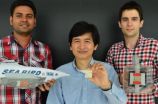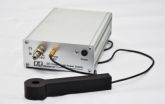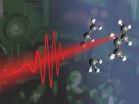(Press-News.org) Nanyang Technological University (NTU) scientists have invented a 'sense-ational' device, similar to a string of 'feelers' found on the bodies of the Blind Cave Fish, which enables the fish to sense their surrounding and so navigate easily.
Using a combination of water pressure and computer vision technology, the sensory device is able to give users a 3-D image of nearby objects and map its surroundings. The possible applications of this fish-inspired sensor are enormous. The sensor can potentially replace the expensive 'eyes and ears' on Autonomous Underwater Vehicles (AUVs), submarines and boats that currently rely on cameras and sonars to gather information about the environment around them.
The revolutionary, low-powered sensor is unlike cameras which cannot see in dark or murky waters; or sonars whose sound waves pose harm to some marine animals.
These extremely small sensors (each sensor is 1.8mm x 1.8mm) are now being used in AUVs developed by researchers from Singapore-MIT Alliance for Research and Technology (SMART), a research centre funded by the National Research Foundation. The centre is developing a new generation of underwater 'stingray-like' robots and autonomous surface vessels.
The new sensors, made using Microelectromechanical Systems (MEMS) technology, will make such robots smarter and prolong their operational time as battery power is conserved.
Associate Professor Miao Jianmin from the School of Mechanical and Aerospace Engineering, and his team of four have spent the last five years in collaboration with SMART to develop micro-sensors that mimic the row of 'feelers' on both sides of the Blind cave fish's body.
Associate Prof Miao said the line of sensors present on the fish's body is the reason why it can sense objects around it and still travel at high speeds without colliding with any underwater obstacles.
"To mimic nature, our team created microscopic sensory pillars wrapped in hydrogel - a material which is similar to the natural neuromasts of the blind cave fish - into an array of two rows of five sensors," Prof Miao said.
"This array of micro-sensors will then allow AUVs to locate, identify, and classify obstacles and objects in water through water pressure and also to optimise its movement in water by sensing the water flow."
The new sensor array which costs below S$100 to make, is also more affordable than sonars, which can detect faraway objects but not nearby objects and cost thousands of dollars.
Partnering Prof Miao to develop the sensors and to adopt it for use on AUVs is Professor Michael Triantafyllou from SMART. Prof Triantafyllou, from SMART's Centre for Environmental Sensing and Modeling (CENSAM), is one of the world's foremost experts on creating underwater robots modelled after aquatic animals like fish.
Current problems with AUVs include poor navigation in murky or cloudy waters such as those off the coast of Singapore, as underwater cameras can only see a short distance, Prof Triantafyllou said.
"Other methods like underwater lights and cameras, acoustic navigation, and sonars also work, but they are very expensive and require very high levels of power that drain the batteries. The new sensors are much cheaper and only require small amounts of power. Also, sensors like sonar are loud and invasive and they may harm aquatic animals that also use sound waves to navigate," the Massachusetts Institute of Technology professor added.
The aim of the AUVs is for environmental sensing, to detect environmental pollution, contaminants and to monitor the overall water quality in Singapore's waters. The AUVs will have chemical sensors installed to detect the chemical condition of water (dissolved oxygen, nutrients, metals, oils, and pesticides), and biological sensors to monitor water conditions such as harmful bacteria and pathogens.
Other potential application of these MEMS sensors, which specialises in near-field detection include defence applications. These can detect nearby submarines without the use of sonar thatgives away one's location.
This collaborative research resulted in two breakthrough papers being accepted for presentation at a prestigious MEMS conference next January in Taiwan, organised by the Institute of Electrical and Electronics Engineers (IEEE).
One paper is for the development of the piezoelectric sensor which does not require any energy as it generates an electric voltage when water flows past the 'feelers'. The second paper focuses on a low-powered biomimetic sensor which can detect underwater objects even when there is little water flowing past it.
To further improve the sensor, Prof Miao's team is now looking to develop a hybrid sensor which will combine both the zero-energy piezoelectric sensor's high accuracy with the low-powered static sensor's ability to detect objects in still water.
INFORMATION:
Media contact:
Lester Kok
Assistant Manager
Corporate Communications Office
Nanyang Technological University
Tel: 6790 6804
Email: lesterkok@ntu.edu.sg
About Nanyang Technological University
A research-intensive public university, Nanyang Technological University (NTU) has 33,500 undergraduate and postgraduate students in the colleges of Engineering, Business, Science, and Humanities, Arts, & Social Sciences. In 2013, NTU will enrol the first batch of students at its new medical school, the Lee Kong Chian School of Medicine, which is set up jointly with Imperial College London.
NTU is also home to four world-class autonomous institutes – the National Institute of Education, S Rajaratnam School of International Studies, Earth Observatory of Singapore, and Singapore Centre on Environmental Life Sciences Engineering – and various leading research centres such as the Nanyang Environment & Water Research Institute (NEWRI), Energy Research Institute @ NTU (ERI@N) and Institute on Asian Consumer Insight (ACI).
A fast-growing university with an international outlook, NTU is putting its global stamp on Five Peaks of Excellence: Sustainable Earth, Future Healthcare, New Media, New Silk Road, and Innovation Asia.
Besides the main Yunnan Garden campus, NTU also has a satellite campus in Singapore's science and tech hub, one-north and is setting up a third campus in Novena, Singapore's medical district. For more information, visit www.ntu.edu.sg
About SMART
The Singapore-MIT Alliance for Research and Technology (SMART) is a major research enterprise established by the Massachusetts Institute of Technology (MIT) in partnership with the National Research Foundation of Singapore (NRF) in 2007. SMART is the first entity in the Campus for Research Excellence and Technological Enterprise (CREATE) being developed by NRF.
SMART is MIT's first, and to-date only, research centre outside the United States. It is also MIT's largest international research programme. MIT faculty members have laboratories at SMART, mentor postdoctoral associates and graduate students, and collaborate with universities, research institutes and industries in Singapore and Asia. For more information, visit: smart.mit.edu/
NTU's 'sense-ational' invention helps underwater vessels navigate with ease
Soon, robots could swim like a fish
2012-12-12
ELSE PRESS RELEASES FROM THIS DATE:
Tsunami caused long-term ecosystem change in the Caribbean
2012-12-12
A detailed analysis of sediments from the island of Bonaire in the Caribbean presents convincing evidence for an extraordinary wave impact dating back some 3,300 years, even though no historical records of tsunamis exist for this island. Of particular interest are the consequences this large wave impact had on the island's ecosystem. The sediments studied by the scientists suggested that this tsunami entirely changed the coastal ecosystem and sedimentation patterns in the area. The work by Dr. Max Engel and colleagues, from the University of Köln in Germany, is published ...
Advance in chromosomal evolution in sea cradles
2012-12-12
The study of chromosome changes arisen during species evolution is a current and intriguing topic that evolutionary biology proposes. However, in several groups (for example, molluscs), and chitons in particular, chromosome studies are scarce, with a few species investigated and analyses performed mostly with simple methods.
Only 2,5% of about 900 living species of chitons have been so far karyologically investigated, all of them in the same order (Chitonida). The authors note that the species of suborder Chitonina all have a karyotype of 2n=24 chromosomes, all biarmed, ...
'Smart stethoscope' advance in monitoring treatment of kidney stones
2012-12-12
A new listening device, developed by scientists from the University of Southampton, is being used to monitor the effectiveness of the treatment of kidney stones - saving patients unnecessary repeat therapy and x-ray monitoring.
If kidney stones cannot be dissolved by drugs, the favoured procedure is lithotripsy. Lithotripsy works by focusing thousands of shock waves onto the kidney stones in an effort to break them into pieces small enough to urinate out of the body or be dissolved by drugs.
However, it is difficult to discover exactly when the treatment has succeeded ...
Rice, Texas Children's team creates biocompatible patch to heal infants with birth defects
2012-12-12
A painstaking effort to create a biocompatible patch to heal infant hearts is paying off at Rice University and Texas Children's Hospital.
The proof is in a petri dish in Jeffrey Jacot's lab, where a small slab of gelatinous material beats with the rhythm of a living heart.
Jacot, lead author Seokwon Pok, a postdoctoral researcher at Rice, and their tissue-engineering colleagues have published the results ofyears of effort to produce a material called a bioscaffold that could be sutured into the hearts of infants suffering from birth defects. The scaffold, seeded with ...
Climate modelers see possible warmer, wetter Northeast winters by 2070
2012-12-12
AMHERST, Mass. – A new high-resolution climate study by University of Massachusetts Amherst climate scientists, the first to apply regional climate models to examine likely near-term changes in temperature and precipitation across the Northeast United States, suggests temperatures are going to be significantly warmer in all seasons in the next 30 years, especially in winter. Also, they project that winters will be wetter, with more rain likely than snow.
Writing in the current issue of the Journal of Geophysical Research, Michael Rawlins and Raymond Bradley of the Climate ...
UGA researchers find algal ancestor is key to how deadly pathogens proliferate
2012-12-12
Athens, Ga. – Long ago, when life on Earth was in its infancy, a group of small single-celled algae propelled themselves through the vast prehistoric ocean by beating whip like tails called flagella. It's a relatively unremarkable tale, except that now, more than 800 million years later, these organisms have evolved into parasites that threaten human health, and their algal past in the ocean may be the key to stopping them.
The organisms are called apicomplexa, but people know them better as the parasites that cause malaria and toxoplasmosis, serious diseases that infect ...
Ultra-short laser pulses control chemical processes
2012-12-12
This press release is available in German.
Chemical reactions occur so quickly that it is completely impossible to observe their progress or to control them using conventional methods. However, new developments in electrical engineering and quantum technology enable us to achieve a more exact understanding and improved control of the behaviour of atoms and molecules. At the TU Vienna, scientists have succeeded in influencing the splitting of large molecules with up to ten atoms using ultra-short laser pulses.
The flash of light which splits molecules
Splitting a ...
Older and younger chronic leukemia patients may need different therapy
2012-12-12
People who develop chronic lymphocytic leukemia (CLL) are typically age 65 and older, but participants in CLL clinical trials are usually several years younger;
The age of CLL patients is not usually considered when determining treatment;
This study suggests that older and younger CLL patients require different therapy.
COLUMBUS, Ohio – Doctors should use different therapies when treating older and younger patients with chronic lymphocytic leukemia, according to a new study led by researchers at the Ohio State University Comprehensive Cancer Center – Arthur G. ...
Researchers shed light on the workings of the body's immune response
2012-12-12
Researchers from Queen Mary, University of London have discovered that two proteins which are believed to play a key role in controlling the body's immune response are found in lower levels in T lymphocytes from patients with multiple sclerosis (MS).
The study found that MS patients' T lymphocytes – types of white blood cells which play an important role in the immune system – were defective at producing the proteins and that this was associated with increased levels of molecules which promote inflammation. The findings are reported in the Journal of Immunology¹.
The ...
Can algae-derived oils support large-scale, low-cost biofuels production?
2012-12-12
New Rochelle, NY, December 12, 2012—ExxonMobil and many other energy companies are investing hundreds of millions of dollars to develop transportation biofuels from renewable resources such as the oil or hydrocarbons produced by microalgae. As global supplies of fossil fuels continue to shrink, biofuels derived from algae represent one promising source of low-cost, scalable renewable energy. The feasibility and economic projections for large-scale biofuels production from microalgae are examined in a Review article and accompanying Commentary published in Disruptive Science ...
LAST 30 PRESS RELEASES:
Making lighter work of calculating fluid and heat flow
Normalizing blood sugar can halve heart attack risk
Lowering blood sugar cuts heart attack risk in people with prediabetes
Study links genetic variants to risk of blinding eye disease in premature infants
Non-opioid ‘pain sponge’ therapy halts cartilage degeneration and relieves chronic pain
AI can pick up cultural values by mimicking how kids learn
China’s ecological redlines offer fast track to 30 x 30 global conservation goal
Invisible indoor threats: emerging household contaminants and their growing risks to human health
Adding antibody treatment to chemo boosts outcomes for children with rare cancer
Germline pathogenic variants among women without a history of breast cancer
Tanning beds triple melanoma risk, potentially causing broad DNA damage
Unique bond identified as key to viral infection speed
Indoor tanning makes youthful skin much older on a genetic level
Mouse model sheds new light on the causes and potential solutions to human GI problems linked to muscular dystrophy
The Journal of Nuclear Medicine ahead-of-print tip sheet: December 12, 2025
Smarter tools for peering into the microscopic world
Applications open for funding to conduct research in the Kinsey Institute archives
Global measure underestimates the severity of food insecurity
Child survivors of critical illness are missing out on timely follow up care
Risk-based vs annual breast cancer screening / the WISDOM randomized clinical trial
University of Toronto launches Electric Vehicle Innovation Ontario to accelerate advanced EV technologies and build Canada’s innovation advantage
Early relapse predicts poor outcomes in aggressive blood cancer
American College of Lifestyle Medicine applauds two CMS models aligned with lifestyle medicine practice and reimbursement
Clinical trial finds cannabis use not a barrier to quitting nicotine vaping
Supplemental nutrition assistance program policies and food insecurity
Switching immune cells to “night mode” could limit damage after a heart attack, study suggests
URI-based Global RIghts Project report spotlights continued troubling trends in worldwide inhumane treatment
Neutrophils are less aggressive at night, explaining why nighttime heart attacks cause less damage than daytime events
Menopausal hormone therapy may not pose breast cancer risk for women with BRCA mutations
Mobile health tool may improve quality of life for adolescent and young adult breast cancer survivors
[Press-News.org] NTU's 'sense-ational' invention helps underwater vessels navigate with easeSoon, robots could swim like a fish




